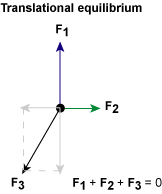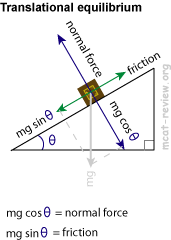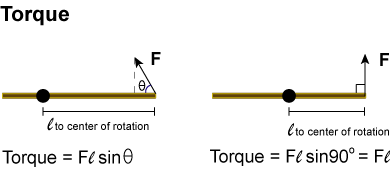|
|
Equilibrium
- When something is in equilibrium, the vector sum of all forces acting on it = 0.
- Another way to put it: when something is in equilibrium, it is either at rest or moving at constant velocity.
- Yet another way to put it: when something is in equilibrium, there is no overall acceleration.
Concept of force, units
- Force makes things accelerate, change velocity or change direction.
- In the MCAT, a force is indicated by an arrow.
- The direction of the arrow is the direction of the force.
- The magnitude of the force is often labeled beside the arrow.
- F=ma, so the unit for the force is kg·m/s2
Translational equilibrium (Sum of Fi = 0)
  
- When things are at translational equilibrium, the vector sum of all forces = 0.
- Things at translational equilibrium either don't move, or is moving at a constant velocity.
- If an object is accelerating, it's not in equilibrium.
- Deceleration is acceleration in the opposite direction.
- At translational equilibrium:
- An apple sitting still.
- A car moving at constant velocity.
- A skydiver falling at terminal velocity.
- NOT at translational equilibrium:
- An apple falling toward the Earth with an acceleration of g.
- A car either accelerating or decelerating.
- A skydiver before he or she reaches terminal velocity.
Rotational equilibrium (Sum of Torque = 0)
- When things are at rotational equilibrium, the sum of all torques = 0.
- Conventionally, positive torques act counterclockwise, negative torques act clockwise.
- When things are at rotational equilibrium, they either don't rotate or they rotate at a constant rate (angular velocity, frequency).
- You cannot have rotational equilibrium if there is angular acceleration.
- Deceleration is acceleration in the opposite direction.
- At rotational equilibrium:
- Equal weights on a balance.
- Propeller spinning at a fixed frequency.
- Asteroid rotating at a constant pace as it drifts in space.
- NOT at rotational equilibrium:
- Unequal weights in a balance such that the balance begins to tilt.
- Propeller spinning faster and faster.
- Propeller slowing down.
Analysis of forces acting on an object
- Draw force diagram (force vectors).
- Split the forces into x, y and z components (normal and parallel components for inclined planes).
- Add up all the force components.
- The resulting x, y and z components make up the net force acting on the object.
- Use Pythagoras theorem to get the magnitude of the net force from its components.
- Use trigonometry to get the angles.
- ... more on vector components
Newton's first law, inertia
- The significance of Newton's first law on equilibrium is: things in equilibrium will remain in equilibrium unless acted on by an external force.
- The significance of Newton's first law on momentum is: things resist change in momentum because of inertia (try stopping a truck. It's not easy because it resists changes to its huge momentum).
- ... more on Newton's first law
Torques, lever arms
- Torque

- Torque is the angular equivalent of force - it makes things rotate, have angular acceleration, change angular velocity and direction.
- The convention is that positive torque makes things rotate anticlockwise and negative torque makes things rotate clockwise.
- Lever
- The lever arm consists of a lever (rigid rod) and a fulcrum (where the center of rotation occurs).
- The torque is the same at all positions of the lever arm (both on the same side and on the other side of the fulcrum).

- If you apply a force at a long distance from the fulcrum, you exert a greater force on a position closer to the fulcrum.
- The catch: you need to move the lever arm through a longer distance.
Weightlessness
- There are two kind of weightlessness - real and apparent.
- Real weightlessness: when there is no net gravitational force acting on you. Either you are so far out in space that there's no objects around you for light-years away, or you are between two objects with equal gravitational forces that cancel each other out.
- Apparent weightlessness: this is what "weightlessness" really means when we see astronauts orbiting in space. The astronauts are falling toward the earth due to gravitational forces (weight), but they are falling at the same rate as their shuttle, so it appears that they are "weightless" inside the shuttle.
Momentum
- Momentum = mv, where m is mass, v is velocity and the symbol for momentum is p.
- Impulse = Ft, where F is force and t is the time interval that the force acts.
- Impulse = change in momentum:

- Conservation of linear momentum
- Total momentum before = total momentum after.
- Momentum is a vector, so be sure to assign one direction as positive and another as negative when adding individual momenta in calculating the total momentum.
- The momentum of a bomb at rest = the vector sum of the momenta of all the shrapnel from the explosion.
- Total momentum of 2 objects before a collision = total momentum of 2 objects after a collision.
- Elastic collisions
- Perfectly elastic collisions: conservation of both kinetic energy and momentum.
- Conservation of kinetic energy: total kinetic energy before = total kinetic energy after.
- Kinetic energy is scalar, so there are no positive / negative signs to worry about.
- If you drop a ball and the ball bounces back to its original height - that's a perfectly elastic collision.
- If you throw a ball at a wall and your ball bounces back with exactly the same speed as it was before it hit the wall - that's a perfectly elastic collision.
- Inelastic collisions
- Conservation of momentum only.
- Kinetic energy is lost during an inelastic collision.
- Collisions in everyday life are inelastic to varying extents.
- When things stick together after a collision, it is said to be a totally inelastic collision.
|
|
